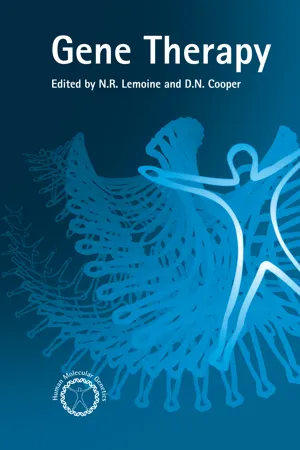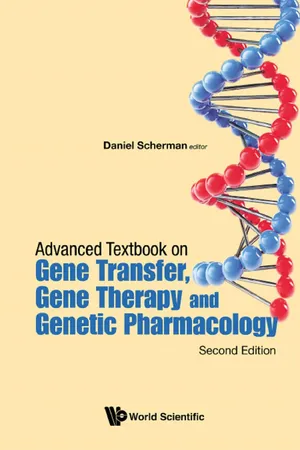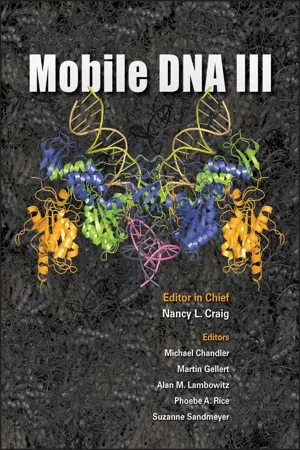Biological Sciences
Adeno Associated Virus
Adeno-associated virus (AAV) is a small, non-pathogenic virus that has gained attention for its potential as a gene therapy vector. AAV is able to infect both dividing and non-dividing cells, making it a promising tool for delivering therapeutic genes into target cells. Its ability to integrate into the host genome and its low immunogenicity make it a valuable candidate for gene therapy applications.
Written by Perlego with AI-assistance
Related key terms
5 Key excerpts on "Adeno Associated Virus"
- eBook - ePub
- David Cooper, Prof Nick Lemoine, David Cooper, Prof Nick Lemoine(Authors)
- 2020(Publication Date)
- Garland Science(Publisher)
5Adeno-associated virus vectors for human gene therapy
Jeffrey S. Bartlett and Richard J. Samulski5.1 Introduction
Presently, human gene therapy is limited by the efficiency of stable gene transfer. To overcome this obstacle, adeno-associated virus (AAV) is being developed as a vector. This unique member of the parvovirus family possesses several properties which distinguish it from other gene transfer vectors. Its advantages include stable and efficient integration of viral DNA into the host genome (Berns et al., 1975; Cheung et al., 1980; Hoggan et al., 1972; Laughlin et al., 1986; McLaughlin et al., 1988), lack of any associated human disease (Berns et al., 1982), broad host range (Buller et al., 1979; Casto et al., 1967), the ability to infect growth-arrested cells (Wong et al., 1993), and the ability to carry non-viral regulatory sequences without interference from the viral genome (Miller et al., 1993a; Walsh et al., 1992). In addition, there has been no superinfection immunity associated with AAV vectors (Lebkowski et al., 1988; McLaughlin et al., 1988).AAV is a defective virus with a unique bi-phasic life cycle. It can be propagated either as a lytic virus or maintained as a provirus integrated into the host cell genome (Atchison et al., 1965; Hoggan et al., 1966, 1972) (Figure 5.1 ). In a lytic infection, replication requires co-infection with either adenovirus (Atchison et al., 1965; Hoggan et al., 1966; Melnick et al., 1965), or herpes simplex virus (HSV) (Buller et al., 1981; McPherson et al., 1985); hence the classification of AAV as a ‘defective’ virus. Vaccinia virus can also provide at least partial helper function (Schlehofer et al., 1986). When AAV infects tissue culture cells in the absence of helper virus, it establishes latency by persisting in the host cell genome as an integrated provirus (Berns et al., 1975; Cheung et al., 1980; Handa et al., 1977; Hoggan et al., 1972). Although AAV physically recombines its DNA into the host cell genome, it can be rescued from the chromosome and re-enter the lytic cycle if these cells are superinfected with helper virus. The lytic phase of the AAV life cycle requires the expression of the adenovirus early gene products (Richardson and Westphal, 1981) Ela (Chang et al., 1989; Richardson and Westphal, 1984), Elb (Richardson and Westphal, 1984; Samulski et al., 1988), E2a (Jay et al., 1979), E4 (Carter et al., 1983; Laughlin et al., 1982; Richardson and Westphal, 1981, 1984), and VA RNA (Janik et al., 1989; West et al., - eBook - ePub
The World Scientific Encyclopedia of Nanomedicine and Bioengineering I
Nanotechnology for Translational Medicine: Tissue Engineering, Biological Sensing, Medical Imaging, and Therapeutics(A 4-Volume Set)
- Yu Cheng, Jia Huang, Yarong Liu, Pin Wang, Bingbo Zhang(Authors)
- 2016(Publication Date)
- WSPC(Publisher)
1 Gene therapy, which is the delivery of genetic material into cells for expression of specific genes, has shown success in a number of monogenic and complex genetic disorders. Gene delivery vehicles used for therapeutic applications can be divided into two classes: viral and nonviral vectors. A major focus of current gene therapy involves disabling the pathological effects of viral vectors. Although they are challenged by the pre-existing immunity of their hosts, viral vectors maintain an advantage over nonviral vectors due to their established gene delivery mechanisms. Common viral vectors that have been studied for potential clinical applications include retroviral vectors, lentiviral vectors, adenoviral vectors and adeno-associated virus (AAV) vectors, which is the focus of this chapter.AAV vectors have gained popularity for gene therapy applications mainly because of their nonpathogenicity and ability to deliver genes to a site-specific location in the host chromosome. Moreover, AAVs have a native tropism to a number of clinically relevant tissues such as the liver, muscles and neuronal tissues, which makes it a promising gene delivery vehicle for therapeutic gene therapy. However, the progress of AAV engineering has been hindered by problems concerning its broad native tropism, pre-existing host immunity and impaired intracellular trafficking. Since the viral capsid protein is the major contributor to these processes, multiple studies have focused on developing strategies to chemically or genetically modify the capsid surface to overcome the systemic challenges. This chapter addresses the various capsid modification strategies adopted for AAV engineering to enhance targeting and transduction efficiency.2.AAV Serotypes
The AAV is a parvovirus initially discovered as a contaminant in simian adenoviral type 15 (SV15) preparations. Over a hundred AAV clones have since been detected in primate genomes. The small, DNA containing particles were first observed in a pooled harvest of rhesus-monkey-kidney-cell (RMK) cultures infected with SV15. Experiments showed that AAV could only replicate in RMK cultures when it is coinfected with SV15, suggesting that AAV particles behave as defective viruses because they cannot replicate in the absence of adenoviruses (Ad).2 Five primate AAVs, which include AAV1–6 except for AAV5, were found as contaminants in preparations of adenovirus.3 In order to isolate new serotypes, laboratories used polymerase chain reaction (PCR) to isolate AAV7–11 and many other clones from human and nonhuman primate genomes.4 −6 - eBook - ePub
Advanced Textbook on Gene Transfer, Gene Therapy and Genetic Pharmacology
Principles, Delivery and Pharmacological and Biomedical Applications of Nucleotide-Based Therapies
- Daniel Scherman(Author)
- 2019(Publication Date)
- WSPC (EUROPE)(Publisher)
99, 11854–11859.Gao, G., Vandenberghe, L.H., Alvira, M.R., et al. (2004). Clades of adeno-associated viruses are widely disseminated in human tissues, J Virol, 78, 6381–6388.Gaudet, D., de Wal, J., Tremblay, K., et al. (2010). Review of the clinical development of alipogene tiparvovec gene therapy for lipoprotein lipase deficiency, Atheroscler Suppl, 11, 55–60.Geoffroy, M.C., Salvetti, A. (2005). Helper functions required for wild type and recombinant adeno-associated virus growth, Curr Gene Ther, 5, 265–271.High, K.A. (2009). The Jeremiah Metzger Lecture: gene therapy for inherited disorders: from Christmas disease to Leber’s amaurosis, Trans Am Clin Climatol Assoc, 120, 331–359.Lux, K., Goerlitz, N., Schlemminger, S., et al. (2005). Green fluorescent protein-tagged adeno-associated virus particles allow the study of cytosolic and nuclear trafficking, J Virol, 79, 11776–11787.Matrai, J., Chuah, M.K., VandenDriessche, T. (2010). Preclinical and clinical progress in hemophilia gene therapy, Curr Opin Hematol, 17, 387–392.McCarty, D.M. (2008). Self-complementary AAV vectors; advances and applications, Mol Ther, 16, 1648–1656.Mingozzi, F., High, K.A. (2011). Therapeutic in vivo gene transfer for genetic disease using AAV: progress and challenges, Nat Rev Genet, 12, 341–355.Nakai, H., Yant, S.R., Stor, T.A., et al. (2001). Extrachromosomal recombinant adeno-associated virus vector genomes are primarily responsible for stable liver transduction in vivo, J Virol, 75, 6969–6976.Nash, K., Chen, W., Salganik, M., et al. (2009). Identification of cellular proteins that interact with the adeno-associated virus rep protein, J Virol, 83, 454–469.Nathwani, A.C., Tuddenham, A.G.D., Rosales, C., et al. (2011). A phase I/II clinical trial entailing peripheral vein administration of a novel self complementary adeno-associated viral vector encoding human FIX for haemophilia B gene therapy. (Abstract) 10th Annual Congress of the Société Française de Thérapie Cellulaire et Génique, June 6–8, 2011, Nantes, France, Hum Gene Ther, 22 - eBook - ePub
- Michael Chandler, Martin Gellert, Alan M. Lambowitz, Phoeba A. Rice, Suzanne B. Sandmeyer(Authors)
- 2015(Publication Date)
- ASM Press(Publisher)
Curr Top Microbiol Immunol 158: 97–129.[PubMed] [CrossRef]19. Buller RM, Rose JA. 1978. Characterization of adenovirus-associated virus-induced polypeptides in KB cells. J Virol 25: 331–338.[PubMed]20. Wistuba A, Kern A, Weger S, Grimm D, Kleinschmidt JA. 1997. Subcellular compartmentalization of adeno-associated virus type 2 assembly. J Virol 71: 1341–1352.[PubMed]21. Rolling F, Samulski RJ. 1995. AAV as a viral vector for human gene therapy. Generation of recombinant virus. Mol Biotechnol 3: 9–15.[PubMed] [CrossRef]22. Warrington KH, Gorbatyuk OS, Harrison JK, Opie SR, Zolotukhin S, Muzyczka N. 2004. Adeno-associated virus type 2 VP2 capsid protein is nonessential and can tolerate large peptide insertions at its N terminus. J Virol 78: 6595–6609.[PubMed] [CrossRef]23. Gao G, Vandenberghe LH, Wilson JM. 2005. New recombinant serotypes of AAV vectors. Curr Gene Ther 5: 285–297.[PubMed] [CrossRef]24. Xie Q, Bu W, Bhatia S, Hare J, Somasundaram T, Azzi A, Chapman MS. 2002. The atomic structure of adeno-associated virus (AAV-2), a vector for human gene therapy. Proc Natl Acad Sci USA 99: 10405–10410.[PubMed] [CrossRef]25. DiMattia M, Govindasamy L, Levy HC, Gurda-Whitaker B, Kalina A, Kohlbrenner E, Chiorini JA, McKenna R, Muzyczka N, Zolotukhin S, Agbandje-McKenna M. 2005. Production, purification, crystallization and preliminary X-ray structural studies of adeno-associated virus serotype 5. Acta Crystallogr Sect F Struct Biol Cryst Commun 61: 917–921.[PubMed] [CrossRef]26. Xie Q, Ongley HM, Hare J, Chapman MS. 2008. Crystallization and preliminary X-ray structural studies of adeno-associated virus serotype 6. Acta Crystallogr Sect F Struct Biol Cryst Commun 64: 1074–1078.[PubMed] [CrossRef]27. Padron E, Bowman V, Kaludov N, Govindasamy L, Levy H, Nick P, McKenna R, Muzyczka N, Chiorini JA, Baker TS, Agbandje-McKenna M. 2005. Structure of adeno-associated virus type 4. J Virol 79: 5047–5058.[PubMed] [CrossRef] - eBook - ePub
- Tadataka Yamada(Author)
- 2011(Publication Date)
- Wiley-Blackwell(Publisher)
Initial studies of intramuscular administration of AAV-2-based vectors for delivering coagulation factor IX in patients with hemophilia B resulted in low levels of protein production [88]. Infusion of higher doses of the recombinant virus into the portal vein of factor IX-deficient dogs resulted in the appearance of 5% of normal levels of factor IX activity in plasma [89]. The efficiency of AAV-mediated cancer gene therapy could be augmented when used in combination with conventional tumor therapies, such as irradiation or chemotherapy [90]. Later studies showed that various AAV serotypes have distinct tissue tropism, depending on their capsids. To date, 11 different serotypes, AAV-1 to AAV-11, and over 100 variants have been isolated from human and nonhuman tissues [91]. Of these 11 serotypes, AAV serotypes 1–9 are being developed as gene therapy vectors. As the AAV-2 genome is well-characterized, it has been cross-packaged with capsids of other serotypes to increase the efficiency of gene transfer. AAV-2/AAV-8 hybrids are particularly efficient for transferring genes into hepatocytes, although the pancreas, heart, and skeletal muscles are additional targets of this hybrid vector.Figure 96.3Generation of recombinant adeno-associated viruses (AAV). To generate AAV vectors, two plasmids, one containing the transgene, flanked by the inverted terminal repeats (ITRs) and the other encoding rep, cap, and adenoviral proteins, are cotransfected into 293 cells, which provide adenoviral E1A in trans. The recombinant virus is “rescued” by infection with a helper adenovirus ( E1 A-deleted) or, more commonly, by transfecting a plasmid that expresses adenoviral proteins.While recombinant AAV vectors persist for up to a year as episomes in hepatocytes, they are eventually lost because of their episomal nature. AAV vectors cause humoral and cellular immune responses, which are hurdles to readministration of a single vector. However, it may be possible to use vectors of alternative capsid serotypes for repeat administration. Attempts are being made to generate AAV vectors with the desired characteristics by mutagenesis of the capsid genes, based on known structural characteristics. An alternative approach is to use random DNA recombination, which leads to viral diversity in nature. Using DNA shuffling techniques, the process of evolution can be accelerated to generate vectors with certain desired attributes, such as the ability to avoid recognition by antibodies and cytotoxic lymphocytes, or to transfer genes into specific tissues with high efficiency [92].Despite several advantages of recombinant AAV vectors, the small stuffing space offered by the small virus limits the size of cDNA that can be accommodated within these vectors. To overcome this problem, the split AAV vector technology has been used to expand the packaging capacity of AAV through head-to-tail dimerization. Essentially, two recombinant vectors are generated. A 5’ vector includes the enhancer/ promoter cassette and a half-intron carrying a splice donor site. A complementing 3’ vector contains another half-intron carrying a splice acceptor site linked with the cDNA encoding the target gene and a polyadenylation signal. Following coin-fection into cells (e.g., 293 cells), genomes of the 5’and 3’vectors dimerize together, thereby expressing the target gene [93].
Learn about this page
Index pages curate the most relevant extracts from our library of academic textbooks. They’ve been created using an in-house natural language model (NLM), each adding context and meaning to key research topics.




